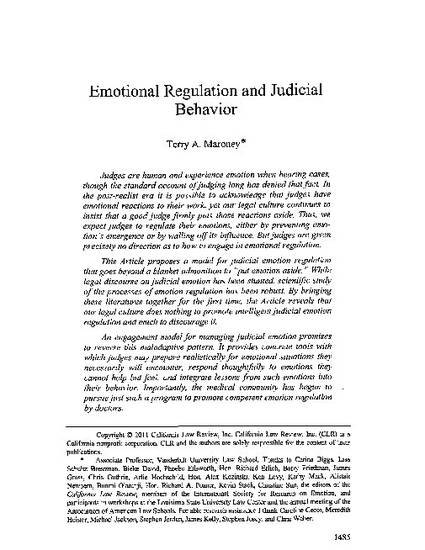
- judges,
- administration of justice
Judges are human and experience emotion when hearing cases, though the standard account of judging long has denied that fact. In the post-Realist era it is possible to acknowledge that judges have emotional reactions to their work, yet our legal culture continues to insist that a good judge firmly puts those reactions aside. Thus, we expect judges to regulate their emotions, either by preventing emotion’s emergence or by walling off its influence. But judges are given precisely no direction as to how to engage in emotional regulation.
This Article proposes a model for judicial emotion regulation that goes beyond a blanket admonition to “put emotion aside.” While legal discourse on judicial emotion has been stunted, scientific study of the processes of emotion regulation has been robust. By bringing these literatures together for the first time, the Article reveals that our legal culture does nothing to promote intelligent judicial emotion regulation and much to discourage it.
An engagement model for managing judicial emotion promises to reverse this maladaptive pattern. It provides concrete tools with which judges may prepare realistically for emotional situations they necessarily will encounter, respond thoughtfully to emotions they cannot help but feel, and integrate lessons from such emotions into their behavior. Importantly, the medical community has begun to pursue just such a program to promote competent emotion regulation by doctors.
The engagement model is far superior to all its alternatives. Other regulation strategies, such as avoidance, are fundamentally incompatible with judges’ professional responsibilities. Suppressing the expression and experience of emotion—encouraged by the status quo—is costly and normatively undesirable. Suppression is unrealistic, exacerbates cognitive load, impairs memory, and can paradoxically increase emotion’s influence while rendering that influence less transparent. The judicial-engagement model, in contrast, leverages the best of what the psychology of emotion regulation has to offer. It puts a name to what extraordinary judges already are doing well and makes it available to all judges. By setting aside not judicial emotion but, rather, the crude manner in which we have asked judges to manage it, we stand materially to improve the quality of judging.
Available at: http://works.bepress.com/terry-maroney/13/
